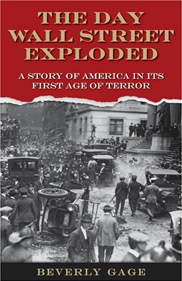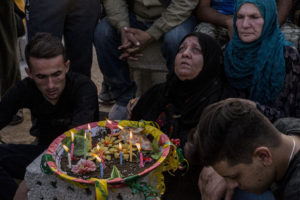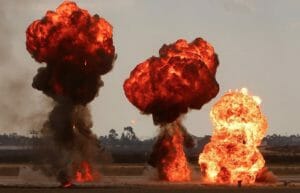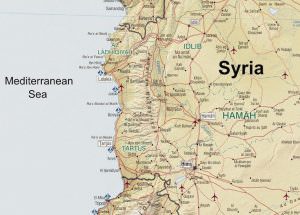Tony Platt on Wall Street Terror Attack
Beverly Gage's new book exhumes a nearly forgotten tale of class warfare -- call it 9/16.
The narrative arc of this book is very familiar: An unexpected terrorist attack takes place in September, targeting an important symbol of power in the heart of New York City; everyday people suffer tragic deaths; the media saturate the nation with images of mangled bodies and tales of heroism; there is an aftermath of recriminations, roundups and xenophobia, followed by acrimonious political debates that pit the need for security against protection of civil liberties.
Except the focus of this book is not on what we now know by shorthand as 9/11, but on the bombing on Wall Street that killed 38 people and wounded hundreds on Sept. 16, 1920 — the single most dramatic act of political violence in this country until Timothy McVeigh blew up the federal building in Oklahoma City 75 years later.
Despite its sensational title, Beverly Gage’s “The Day Wall Street Exploded: The Story of America in Its First Age of Terrorism” is a thoroughly documented work of investigative history and a corrective to the American tendency, in the words of Richard Hofstadter, to practice a “remarkable lack of memory.” Gage challenges the assumption widely expressed after 9/11 that “terrorism is something utterly new in the American experience, a horror without a past.” To illustrate this point, she focuses on the rise and fall of the American anarchist movement from the 1880s through the 1920s, and the state’s response to early 20th century radicalism, which talked up “propaganda by deed” and to back up its rhetoric made considerable use of dynamite, Alfred Nobel’s contribution to science in 1866.
Gage also tackles the analytical impasse created by right-wing depictions of anarchists as crazed bomb-throwers and left-wing apologies that portray anarchist radicals as romanticized victims of government conspiracies. “There were bombs and those who believed in bombs,” she argues, “and there was also scapegoating, stereotyping, and false accusation.”
“The Day Wall Street Exploded” revisits the first part of the 20th century as an important moment in the development of what historian William Preston Jr. called the “internal security state.” American historians have extensively explored the Red Scare, Palmer Raids, political deportations and anti-radical hysteria of the 1910s and 1920s; Gage’s original contribution is to witness these ominous events through the perspective of participants in radical organizations, and in the police and intelligence agencies that aspired not only to defeat the left but also to make anti-radicalism into “a litmus test for entry into American politics.”
Beverly Gage has turned her Columbia University dissertation — recipient of the prestigious Bancroft award in 2004 — into an engaging first book. From her podium as an assistant professor of history at Yale, she is quickly making a reputation as a public intellectual, her opinions appearing in The New York Times Magazine, Slate and PBS’ “News Hour.” Recently recognized by the History News Network as a “top young historian,” Gage draws upon her journalism skills practiced at the New Haven Advocate to fashion a lively narrative, leavening solid research with deft prose and expressive sketches of her leading subjects. Occasionally style trumps substance as Gage tries to meet expectations of the book’s hype as “a thrilling historical detective saga,” but overall she succeeds in making a serious subject accessible to a broader audience.
|
To see long excerpts from “The Day Wall Street Exploded,” click here. |
The book is roughly divided into two parts: The first introduces us to the world of American anarchism, a product of the 19th century’s ferocious industrialization and class divide; the second to the architects of a modern system of law and order that shaped 20th century counterinsurgency.
Gage provides a portrait of the militant American left from the eruption of labor strikes in the 1880s to the Russian Revolution. We get sympathetic snapshots of all the key players and organizations: the anarchist leader Johann Most, who “helped to transform the neutral substance of dynamite into a great political symbol”; Emma Goldman, the “figurehead of American anarchism,” and her partner in militancy, Alexander Berkman; the labor leader Big Bill Haywood, “the American apostle of dynamite” who “projected a magnetism far beyond his physical frame”; and Sacco and Vanzetti, advocates of an “unabashedly revolutionary form of anarchism,” whose 1927 executions became an international cause célèbre. Gage also brings us inside the internal debates about the use of violence against commercial and political targets taking place within anarchist, Bolshevik and socialist organizations.
What’s missing from this U.S.-centered analysis, however, is an exploration of how the issue of political violence was viewed within mainstream labor, women’s and civil rights organizations. From reading Gage’s book you wouldn’t know, for example, that a huge debate was taking place within the contemporary African-American movement about whether or not violent self-defense was preferable to nonviolent protest. “I believe it would be better for the Negro’s soul to be seared with hate than dwarfed by self-abasement,” argued a black leader in the early 1920s.
Anarchism in the United States was never a mass or popular movement. In the mid-1880s, the country’s largest anarchist group had no more than 6,000 members, mostly German immigrants. And of these committed militants, notes Gage, only a few subscribed to tactics of “scorching vengeance.” Moreover, the violence of the left paled against the ruthless violence used by cops and private militias against striking workers, and the thousands of untimely deaths caused by unsafe working conditions in mines, mills and factories.
Yet, when revolutionaries turned to violence, the results were spectacular: the Haymarket bombing in Chicago in 1886 that left seven cops dead and 60 injured; the assassination of President William McKinley in 1901; the 1910 firebombing of the Los Angeles Times building; the 1916 bomb that killed 10 spectators at the Preparedness Day parade in San Francisco; and the 1919 bomb that sheared off the front of the house of the U.S. attorney general. In 1920, a group calling itself “American Anarchist Fighters” left leaflets near the site of the Wall Street explosion, demanding, “Free the political prisoners, or it will be sure death for all of you.” But the 1920 action was the death knell of the anarchist movement, not of the Wall Street plutocrats whom it had targeted. Its demise was the result in part of the growth of labor, socialist and communist organizations that increasingly rejected the use of terror as a tactic on the grounds that it alienated mass support and inevitably generated what today we would call “collateral damage.” The 38 people who died on Wall Street were not bankers and speculators, but messengers, stenographers, clerks, salesmen and drivers. While Beverly Gage is not as blunt as writer Mike Davis, who calls the use of dynamite in public places “an inherently fascist weapon,” she leaves no doubt about where her ultimate sympathy lies: The book ends with an in memoriam to the victims of the Wall Street explosion.
The thread that holds the book’s disparate elements together is the unsolved bombing that almost pierced the inner sanctum of American capitalism. “The Day Wall Street Exploded” works best when it investigates in great detail the bumbling incompetence and internecine squabbling among the various public and private agencies attempting to track down the group or person responsible for what the press described as an outrage “unprecedented in horror.”
Gage brings to life the various departments and larger-than-life personalities who vied with each other to break the case. Whether New York Police Commissioner Arthur Woods, or Bureau of Investigation Director William Flynn, or his replacement (the founder of the William J. Burns International Detective Agency), each public figure turned the investigation into a fiasco, with several suspects arrested and discarded before trial, and money wasted in sending agents on fishing expeditions for red herrings in Russian and Italy. Five years after the Wall Street bombing, the case was unsolved, and it would remain so.
The only functionary to emerge from the debacle unscathed was a young and opportunistic J. Edgar Hoover, who parlayed his experience as a Library of Congress cataloger into becoming the custodian of the Justice Department’s new Radical Division, eventually amassing files on 450,000 suspected radicals. In 1924 he was promoted to director of the Bureau of Investigation and in the 1940s as head of the now renamed Federal Bureau of Investigation would successfully lead a witch hunt against the leadership of the Communist Party.
This long section of the book is a good read as Gage draws us into the hunt for the Wall Street bomber. By the time we reach the last chapter, we are invested in figuring out who pulled off the operation. Three pages from the end of the book, Gage delivers a coup de theatre, revealing that another historian, Paul Avrich, in his definitive 1991 book on American anarchism, had proposed Mario Buda, a comrade of Sacco and Vanzetti, as the likely candidate. As far as Gage — as well as Mike Davis — is concerned, Avrich probably got it right, given that the September 16th bombing took place five days after Sacco and Vanzetti were indicted. I understand why as a dramatic technique Gage withheld Avrich’s 18-year-old thesis until the last three pages of the book, but it’s surprising that she did not give Buda the same kind of detailed attention that she devoted to other suspects.
Although the government bungled the prosecution of the Wall Street bomber, it succeeded before, during and after World War I in creating an unprecedented network of domestic counterinsurgency operations. In February 1917, Congress passed legislation making advocacy of destruction of property or assassination of a public official grounds for deportation. After President Woodrow Wilson declared war on Germany on April 2, hundreds of radicals were rounded up. The June 15 Espionage Law made it a crime to oppose the war, resulting in the jailing of more than 1,000 anti-war activists.
After the war, Attorney General A. Mitchell Palmer set out to purge the country of its “anarchist element,” starting with the arrests of hundreds of members of the little-known Union of Russian Workers; the roundup of thousands of foreign-born anarchists and communists followed in November 1919. If the Palmer Raids, as they became known, were aimed at deporting political activists, the nativist immigration law of 1924 was designed to prevent leftists from entering the country. The result, notes Gage, was the “first mass political deportation in American history.” Meanwhile, at the local level, state legislatures cracked down on “criminal anarchy,” while police departments set up “Red squads” and sent spies and agents provocateurs into hundreds of leftist organizations.
Among the victims of this “madness of jingoism,” as Emma Goldman put it, were the crème de la crème of the American left: Big Bill Haywood did time and then secretly left the country before his re-arrest, dying in Moscow; Goldman and Alexander Berkman were imprisoned and later deported with 250 comrades to Russia; even the more moderate Eugene Debs, then 63 years old, was put in prison in May 1918 after he gave an anti-war speech in Canton, Ohio. By the mid-1920s, the once vibrant and optimistic American left was on the run.
In the aftermath of 9/11, while working on “The Day Wall Street Exploded,” Gage worried that it might not be possible “to write decent history on a subject so heavily publicized. Most of all,” she asked herself, “did the entire subject now seem too ghoulish and opportunistic?” She was reluctant, with good reason, to make facile comparisons between late 20th century jihadism and early 20th century anarchism. “I no longer feel quite so much urgency,” she concluded, “to compare the present and past, or to justify my subject in relation to the present day.”
But it’s a pity that Gage did not take the opportunity to make clear what is implicit in her book: that the repertoire of post-9/11 repression — punishment without trial, rendition, demonization of immigrants, racial profiling, left baiting and invasion of privacy — was shaped by events in the 1910s and 1920s when for the first time the government orchestrated and led campaigns to limit political dissent, whipped up right-wing populism and justified suspension of the Constitution in the name of national security. Sen. Hiram Johnson’s critique of the Republican Party in 1920 as “bowing to a hundred repressive acts” works just as well as a critique of the legacies of the Bush administration. To paraphrase the senator’s most famous maxim, the first casualty of counter-terrorism is truth.
|
Tony Platt, professor emeritus at Sacramento State University, is the author, with Cecilia O’Leary, of “Bloodlines: Recovering Hitler’s Nuremberg Laws, From Patton’s Trophy to Public Memorial” (2006). His blog is posted at GoodToGo.typepad.com. |
Independent journalism is under threat and overshadowed by heavily funded mainstream media.
You can help level the playing field. Become a member.
Your tax-deductible contribution keeps us digging beneath the headlines to give you thought-provoking, investigative reporting and analysis that unearths what's really happening- without compromise.
Give today to support our courageous, independent journalists.








You need to be a supporter to comment.
There are currently no responses to this article.
Be the first to respond.